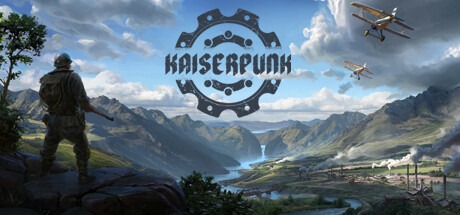Salute future generals!
As you're probably already aware, Kaiserpunk is set in an alternate history setting. Events from our familiar reality, and events happening in Kaiserpunk start to diverge at the very end of World war I.
And that means events preceding roughly 1918 still happened, technological source was familiar, industry levels were in line with what we know from history books…
Before the start and during the production of Kaiserpunk, we therefore attempted to remain in line with history as much as possible, at least up until the point where it spreads into alternative possibilities. And during various stages of research we did on the subject, numerous fascinating facts became clearer to us. You can call it pieces of history trivia if you'd like. Anyway we got the urge to share some of these things with you. Since many of you might be interested in a little bit of a historical background, and history is often fascinating more than it appears on the surface, let's share some of the facts we learned…starting with one of the most prominent symbols of modern warfare…a tank.

World War I started without tanks on any of the sides in the conflict. At least without any tanks being in active service. The notion of most generals was that battles will be similar to battles from recent wars (Franco-Prussian conflict for example), so they prepared similar strategies and a similar mindset. However, due to the advancement of raw firepower and destructive might of countless thousands of artillery pieces scattered on the vast European frontlines, it soon became obvious that this war will be unlike any seen before. This knowledge was sadly paid in millions of lives.
Locked in endless attritional battles and unable to significantly move in any direction, engineers scrambled to find any solution to break the deadlock. It was a time of unprecedented innovation, a time that also spawned some ridiculous contraptions, but also some of the weapons that lived to be an actual game changer on the battlefields. Behold the tank!
Several European armies have been working on something resembling a tank for some time, but the poor progress of the war made these efforts faster. The main problem was that no one knew what the main purpose of this new weapon should be. They only realized they now have the technical ingredients to assemble such a monstrosity – proper internal combustion engine, armor plating, sufficiently small cannons... so they built the first prototypes. Note that dynamic mobile warfare and rapid armored forces wasn't a thing yet. Horses were still a vital part of the transport system, cavalry units still had their place in army organization, so the tank was yet to find its place.

The first tank to actually be deployed on a battlefield was the British Mark I tank in 1916. It was a metal monster with visible identity crisis in its infancy. Its creators believed its best purpose will be to drive across no man’s land, have the ability to cross trenches and protect the crews while kilometers of barbed wire get trampled in the process, and then the real army can do the actual fighting. Did it work? Well, not exactly. Initial effects were great – the enemy units were terrified of this weird, loud and intimidating weapon, but destroying it wasn't actually too big of a challenge. The fact that more than half of them broke down on their own due to technical issues definitely didn't do any favors to the image of this wonder weapon.
Still, seeing them in real combat sparked additional ideas of what tanks could be used for. And so the race to develop newer and better tanks started. Some models were designed to really serve as simple moving cannons – protected enough to approach enemy lines and open fire from point blank range. Others believed that tanks could become land dreadnoughts, an equivalent of sea warships, so they mounted obscene amounts of firepower. But that caused all sorts of other problems in these, still very unsophisticated machines. They were extremely heavy, slow and excellent targets due to their size.
From the design of early tanks, it was clear that no one at that time had any idea what tanks can and should be in the future. Models were vastly different in sizes, firepower, armor, agility and pretty much every other specification. It was almost impossible to see two similar ideas. It was simply a race to make as many of them as possible, and to test out as many variations as possible, and then observe which variant was effective in combat. But this insane pace of development and constant modifications to every single model made them also highly undependable and prone to all sorts of malfunctions. At some moments these issues led some commanders to determine that a tank is generally a stupid idea that will never be broadly useable.

However, by the end of World War I, and against all the odds, the tank managed to survive. Its capabilities secured advantage in certain points of the battlefield, its maneuverability did occasionally break the entrenched lines and its appearance still yielded a psychological effect on enemies.
In time, and after all the experiences from WWI were analyzed, the generals also got a clearer picture of what place the tank is to have in future warfare. They became better armed, better protected, more reliable, faster and easier to maintain. And in just a couple of decades, tanks will become synonymous with modern warfare bringing a new type of fast, maneuverable combat. Once a mechanical monstrosity without a clear goal on the battlefield, the tank turned into a decisive weapon that commanded the field of war and forced all other units to adapt to it.
Hope you find this as interesting as we do. Until next time!
Sources for photographs:
French World War tank
https://tankmuseum.org/article/french-first-world-war-tanks
British Mark I tank
https://www.warhistoryonline.com/whotube-2/need-know-british-mark-iv-tank-watch.html
German A7V World War tank
https://www.abc.net.au/news/2015-07-28/sole-surviving-german-wwi-tank-on-display-aust-war-memorial/6654320
